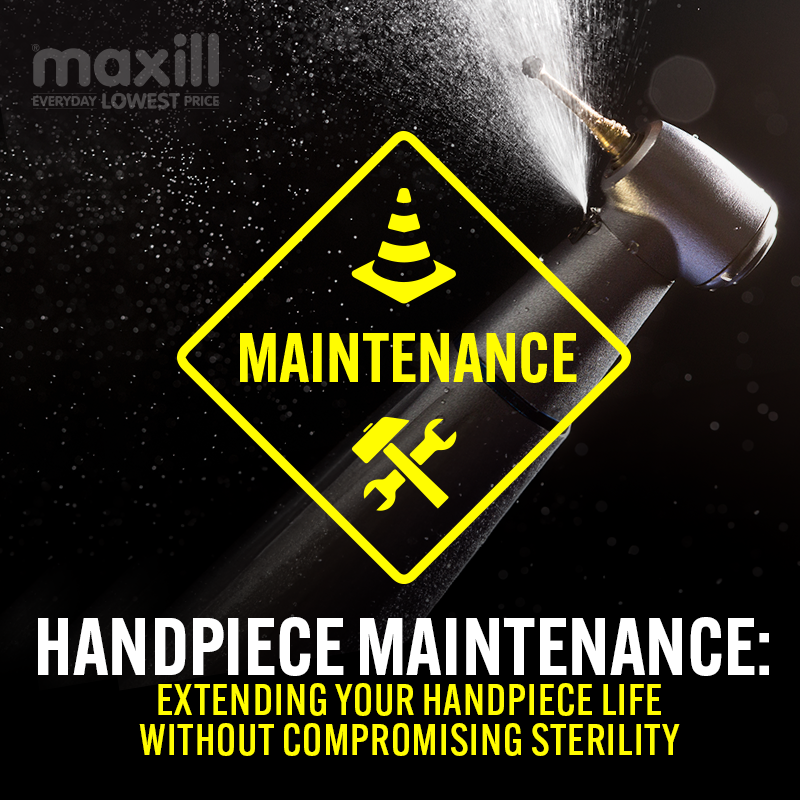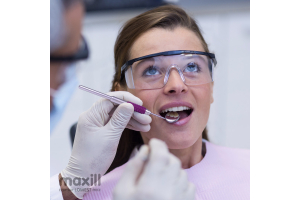Handpiece Maintenance: Extending the Life of Your Dental Handpieces

Dental handpieces are a dental office's most essential and costly investment. Handpieces are the workhorses of the practice. Whether high-speed, low-speed, or cordless, handpieces are considered semi-critical dental devices that must be reprocessed appropriately to avoid harming the device, causing it to operate ineffectively, or reducing its productive life while maintaining sterility.
Dental handpieces contact mucous membranes and oral fluids. These instruments have not been associated with disease transmission at this time; however, high-speed and low-speed handpieces can retract oral fluids into the internal workings of the handpiece. DNA of viruses has been found inside both highspeed handpieces and prophy angles. If not cleaned and sterilized correctly, this debris could later be transferred to the mouths of other patients.
Handpiece Life
The average life of a highspeed dental handpiece is approximately 8-14 months. Of course, this depends on frequency and how it is used, along with how it is maintained. Some recommendations for extending the life of the handpiece include following the manufacturer's instructions for use (IFU), depending on the brand or type of handpiece. Ensure all dental team members know the IFU and keep the instructions in a common area that is easily accessible, so all staff can reference them.
Schedule a training session if a new handpiece is purchased or a new team member takes over the reprocessing duties. It's always a good idea to have refresher training periodically so that the temptation to rush or take shortcuts in reprocessing does not occur. There are also recommendations to have a handpiece serviced before issues arise.
Have a schedule with the manufacturer to inspect and refurbish the handpiece when the office is on vacation or holiday so that the handpieces are back, ready to work hard for you again.
Regulation of Handpieces Old and New
Dental handpieces are medical devices regulated by the U.S. Food and Drug Administration (FDA). This agency guides manufacturers in writing and scientifically validating reprocessing instructions. According to the FDA and supported by the Centers for Disease Control (CDC), older equipment and their IFU, 2015 and prior, may not be consistent with state-of-the-art science and, therefore, may not ensure that the device is clean, disinfected, or sterile.
The manufacturer must update and provide sufficient instructions on preparing the devices for the next patient. In all cases following the 2015 updated guidance, dental handpieces that connect to air/water lines must be heat sterilized and have FDA clearance with validated instructions for reprocessing; if they do not meet these criteria, the instrument should not be used. Cleaning and lubrication are the most critical steps for maintaining your handpieces, to ensure performance and durability.
The manufacturers spend time researching and supplying specific instructions for their products. Failure to follow these instructions can void the warranty of the handpiece. The FDA maintains a database of devices intended for human use that must follow specific regulations to be cleared. You can find out if your handpiece is FDA-cleared here - FDA 510(k) Premarket Notification.
General Recommendations for Handpiece Processing
- Before removing the handpiece from the air/water line, run the handpiece with the bur still in place to flush water and airlines.
- Remove the bur and wipe visible debris from the outer surfaces of the handpiece with running water or an acceptable cleaning agent recommended by the manufacturer.
- If the handpiece requires lubrication before heat-processing, use a handpiece cleaner recommended by the manufacturer. This product should remove the internal debris as well as lubricate the handpiece.
- Do not overlubricate handpieces.
- Reattach the handpiece to the airline and operate the handpiece to expel excess lubricant from internal parts. If this step is not done before heat sterilization, the excess lubricant becomes sticky, interferes with sterilization, and slows the rotating internal components.
- Use a cotton swab dampened with isopropyl alcohol to remove lubricant from the fiberoptic surfaces.
- After flushing and lubricating (if necessary), place the dry handpiece into the sterilization package and sterilize accordingly, referring to IFU.
- Allow the handpiece to cool. Keep the handpiece in a sterilization package/pouch until using the handpiece for patient care.
- Never run the hot handpiece under water to speed up the cooling process; this quick temperature change can damage delicate parts of the device.
*An alternative is to use an automated cleaner/lubricator device and then follow the appropriate sterilization recommendations for that device.
Conclusion
In conclusion, dental handpieces, being essential and costly investments in a dental office, serve as workhorses with significant impact on patient care. Classified as semi-critical devices, their appropriate reprocessing is crucial to prevent harm, inefficiency, and reduced longevity, while maintaining sterility. Although not currently linked to disease transmission, high-speed and low-speed handpieces pose a risk of fluid retraction and DNA debris retention. Managing handpiece life involves adherence to manufacturer instructions, regular training, and proactive servicing. FDA regulations emphasize updated guidelines for reprocessing, highlighting the importance of compliance to ensure cleanliness and sterilization.
General recommendations stress meticulous cleaning, lubrication, and proper sterilization methods, with careful attention to detail during each step. Despite the absence of direct disease association, the potential for contamination underscores the significance of rigorous infection control practices. By following these guidelines, dental clinics can ensure proper reprocessing, thereby extending the life of these critical devices and mitigating infection risks in patient care.
References
Organization for Safety, Asepsis, and Prevention. (2019). From Policy to Practice: OSAP's Guide to the CDC Guidelines. OSAP.
U.S. Food and Drug Administration. (2015). Reprocessing Medical Devices in Health Care Settings: Validation Methods and Labeling. U.S. Food and Drug Administration, U.S. Dept. of Health and Human Services. https://www.fda.gov/regulatory-information/search-fda-guidance-documents/reprocessing-medical-devices-health-care-settings-validation-methods-and-labeling.







